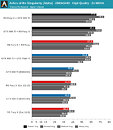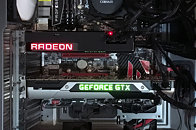- Joined
- Oct 9, 2007
- Messages
- 47,324 (7.51/day)
- Location
- Hyderabad, India
| System Name | RBMK-1000 |
|---|---|
| Processor | AMD Ryzen 7 5700G |
| Motherboard | ASUS ROG Strix B450-E Gaming |
| Cooling | DeepCool Gammax L240 V2 |
| Memory | 2x 8GB G.Skill Sniper X |
| Video Card(s) | Palit GeForce RTX 2080 SUPER GameRock |
| Storage | Western Digital Black NVMe 512GB |
| Display(s) | BenQ 1440p 60 Hz 27-inch |
| Case | Corsair Carbide 100R |
| Audio Device(s) | ASUS SupremeFX S1220A |
| Power Supply | Cooler Master MWE Gold 650W |
| Mouse | ASUS ROG Strix Impact |
| Keyboard | Gamdias Hermes E2 |
| Software | Windows 11 Pro |
One of biggest features of DirectX 12 is its asymmetric multi-GPU that lets you mix and match GPUs from across brands, as long as they support a consistent feature-level (Direct3D 12_0, in case of "Ashes of the Singularity"). It's not enough that you have two DirectX 12 GPUs, you need DirectX 12 applications to make use of your contraption. Don't expect your older DirectX 11 games to run faster with a DirectX 12 mixed multi-GPU. Anandtech put Microsoft's claims to the test by building a multi-GPU setup using a Radeon R9 Fury X, and a GeForce GTX 980 Ti. Some interesting conclusions were drawn.
To begin with, yes, alternate-frame rendering, the most common multi-GPU method, works. There were genuine >50% performance uplifts, but nowhere of the kind you could expect from proprietary multi-GPU configurations such as SLI or CrossFire. Second, what card you use as the primary card, impacts performance. Anandtech found a configuration in which the R9 Fury X was primary (i.e. the display plugged to it), and the GTX 980 Ti secondary, to be slightly faster than a configuration in which the GTX 980 Ti was the primary card. Mixing and matching different GPUs from the same vendor (eg: a GTX 980 Ti and a GTX TITAN X) also works. The best part? Anandtech found no stability issues in mix-matching an R9 Fury X and a GTX 980 Ti. It also remains to be seen how long this industry-standard utopia lasts, and whether GPU vendors find it at odds with their commercial interests. Multi-GPU optimization is something both AMD and NVIDIA spend a lot of resources on. It remains to be seen how much of those resources they'll be willing to put on a standardized multi-GPU tech, and away from their own SLI/CrossFire fiefdoms. Read the insightful article from the source link below.



View at TechPowerUp Main Site
To begin with, yes, alternate-frame rendering, the most common multi-GPU method, works. There were genuine >50% performance uplifts, but nowhere of the kind you could expect from proprietary multi-GPU configurations such as SLI or CrossFire. Second, what card you use as the primary card, impacts performance. Anandtech found a configuration in which the R9 Fury X was primary (i.e. the display plugged to it), and the GTX 980 Ti secondary, to be slightly faster than a configuration in which the GTX 980 Ti was the primary card. Mixing and matching different GPUs from the same vendor (eg: a GTX 980 Ti and a GTX TITAN X) also works. The best part? Anandtech found no stability issues in mix-matching an R9 Fury X and a GTX 980 Ti. It also remains to be seen how long this industry-standard utopia lasts, and whether GPU vendors find it at odds with their commercial interests. Multi-GPU optimization is something both AMD and NVIDIA spend a lot of resources on. It remains to be seen how much of those resources they'll be willing to put on a standardized multi-GPU tech, and away from their own SLI/CrossFire fiefdoms. Read the insightful article from the source link below.



View at TechPowerUp Main Site





